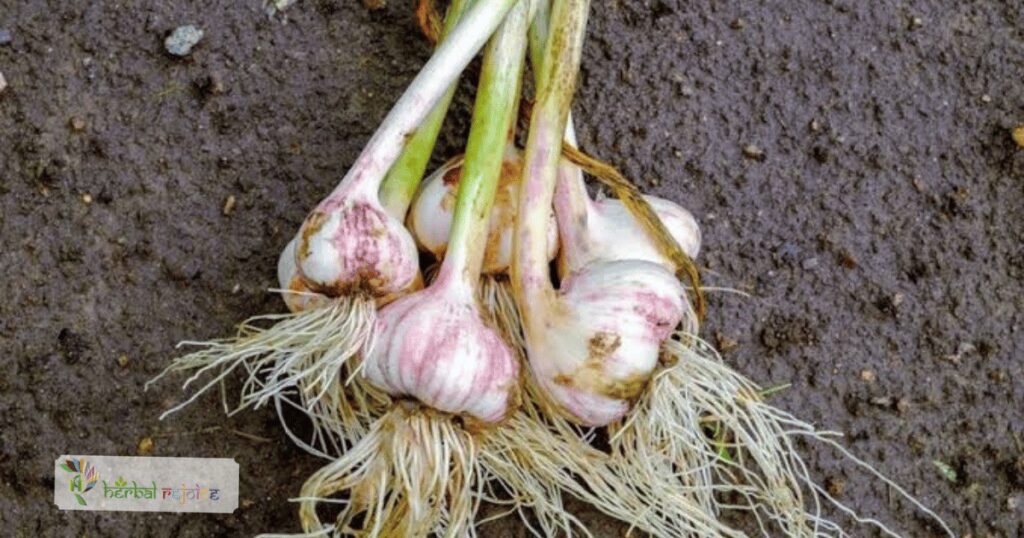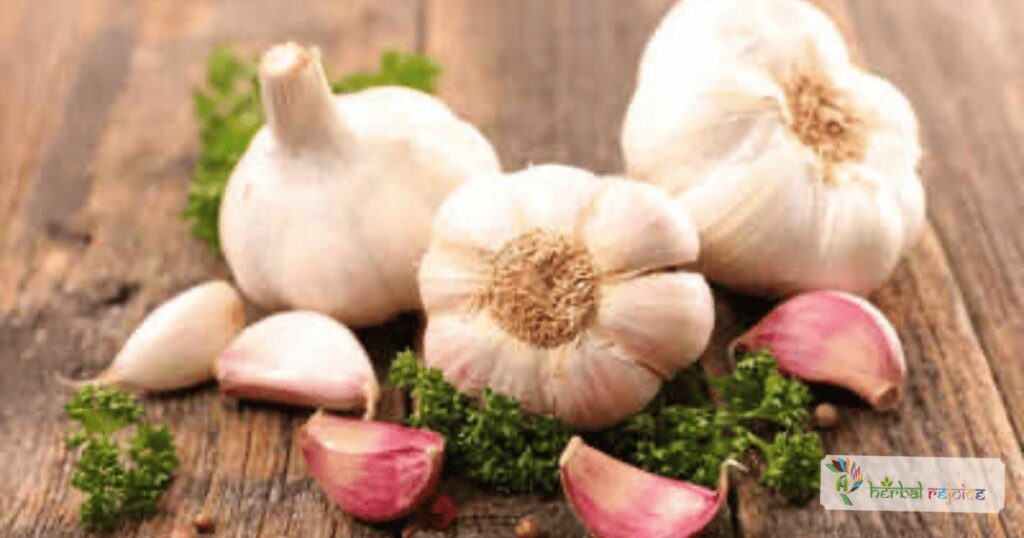Unveiling the Healing Magic of Garlic from History to Health Benefits. Discover its Culinary Marvel, Cardiovascular Support, Cancer Potential & More.
Biological Source and Geographical Origin
Garlic, scientifically known as Allium sativum Linn., belongs to the family Liliaceae. It is derived from the bulbs of the plant and contains not less than 0.2 per cent of alliin on a dried basis. Widely cultivated in Central Asia, Southern Europe, USA, and India, garlic thrives in almost all Indian states and serves as a spice or condiment crop.
Chemical Constituents: Unlocking Garlic’s Potent Properties
Garlic bulbs boast a nutritional profile comprising 29 per cent carbohydrates, about 56 per cent proteins (albumin), 0.1 per cent fat, mucilage, and 0.06 to 0.1 per cent of volatile oil.
The chief active constituent of garlic is the volatile oil, which includes allyl propyl disulphide, diallyl disulphide, alliin, and allicin. Notably, alliin converts into allicin through the action of the enzyme alliinase. Moreover, garlic oil is yellow in colour and optically inactive.
Versatile Uses of Garlic: A Healing Wonder

Garlic finds extensive applications in natural medicine, making it a valuable ally for various health conditions.
It is a carminative, aphrodisiac, expectorant, stimulant, and disinfectant in treating pulmonary ailments.
As a widely used condiment, garlic oil is an anthelmintic and rubefacient. Its antibacterial properties make it effective in combating infections, while garlic oil proves helpful in addressing high blood pressure and atherosclerosis.
Fresh garlic is a preventive measure against amoebic dysentery, showcasing strong antioxidant effects.
Storage: Ensuring Garlic’s Potency
Garlic’s medicinal potency can be preserved through proper storage. It is prone to degradation and should be carefully stored at zero degrees centigrade and 65 per cent relative humidity.
Global Influence and Timeless Healing
Garlic’s healing properties have garnered widespread recognition across cultures and centuries. From ancient civilizations such as the Chinese, Greeks, Romans, and Egyptians to modern scientific studies, garlic’s role as a potent remedy has remained constant.
It was even fed to the enslaved people who built the Great Pyramid to enhance their endurance. Renowned French scientist Louis Pasteur was the first Westerner to document garlic’s anti-infective properties in 1858.
Botanical and Phytochemical Insight: Unravelling the Magic of Garlic
The distinct fragrance of garlic is unlocked when the clove is broken, and alliin encounters the enzyme allinase, forming the aromatic compound allicin.
Although allicin is widely researched, other sulfur-containing chemicals in garlic may also play vital health-promoting roles.
Furthermore, garlic is a rich source of vitamins and trace minerals, including selenium, adding to its medicinal value.
The Science of Garlic: A Natural Shield for Heart Health
Garlic’s reputation as a natural protector against heart disease is well-founded. Its potential benefits stem from its influence on blood lipids, clotting factors, and blood pressure.
Studies have suggested that garlic can lower cholesterol levels by approximately 10 per cent. While the results have varied, the overall effects support incorporating garlic into the diet for cardiovascular well-being.
Garlic’s ability to reduce platelet stickiness and maintain blood vessel flexibility further lowers blood pressure.
Garlic and Cancer: A Promising Frontier
Garlic’s potential in preventing and treating cancer has piqued considerable interest.
Animal studies demonstrate its ability to reduce the risk of chemically-induced tumours and treat certain cancers.
Human studies suggest that a garlic-rich diet may provide protection against stomach and breast cancer.
Additionally, garlic’s anti-infective properties have shown promise in treating various diseases, from athlete’s feet to serious infections common in AIDS patients.
Practical Applications: Embracing the Healing Benefits
Garlic’s practical uses span a wide range of illnesses and conditions. It has proven effective in treating lung congestion, alleviating arthritic stiffness and pain, and calming hysteria.
Its applications extend to promoting normal menstruation in women and enhancing libido in men. Topically, garlic oil is a liniment for sore muscles and hastens the healing of festering sores.
With its versatility in heart disease, cancer, and beyond, garlic continues to captivate medical researchers exploring its therapeutic potential.
Incorporating Garlic Into Your Lifestyle: A Natural Rejuvenative
At Herbal Rejoice, we recommend garlic as a grounding rejuvenate for individuals experiencing mental turbulence. For those with mildly elevated cholesterol or high blood pressure, adding a clove of garlic to sautéed vegetables or pasta sauce may reduce the need for medication.
Introducing a couple of garlic cloves per day before prolonged antibiotic therapy may prove beneficial for individuals with recurrent peptic ulcers.
For stubborn skin infections, directly applying freshly squeezed garlic oil to the affected area thrice a week can offer relief. With similar benefits but a less pungent odour, Leeks provide an alternative for those sensitive to garlic’s strong smell.
Ayurveda’s Wisdom: Recognizing Garlic’s Potency
Ayurveda acknowledges garlic’s healing prowess, encompassing five of the six tastes but lacking sour. It balances Vata and Kapha, but its moderate heating influence may aggravate Pitta.
While Ayurvedic texts advise moderate garlic use during spiritual practices due to its potential to dull the mind or stimulate sexual passion, garlic is a valuable addition to enhancing overall health and well-being for most individuals.
Precautions for Optimal Use: Navigating Garlic’s Benefits
Garlic’s therapeutic effects necessitate some precautions. When incorporating garlic into their routines, individuals on blood pressure medications should monitor their levels to avoid overtreating hypertension.
Furthermore, those taking blood-thinning medicines should exercise caution due to garlic’s potential blood-thinning properties.
Conclusion: Embrace the Healing Magic of Garlic
In conclusion, garlic is a natural wonder, celebrated across cultures and generations for its unparalleled healing benefits. From cardiovascular health to cancer prevention and anti-infective properties, garlic’s prowess as a natural pharmacy remains unparalleled.
At Herbal Rejoice, we invite you to explore the extraordinary world of garlic and harness its healing power to embrace a healthier, happier life.
Frequently Asked Questions (FAQ) about Garlic
What is the biological source of garlic?
Garlic is derived from Allium sativum Linn. bulbs, belonging to the family Liliaceae. These bulbs contain not less than 0.2 per cent of alliin on a dried basis.
Where is garlic cultivated geographically?
Garlic is cultivated in Central Asia, Southern Europe, USA, and India. It is found in almost all states and is grown as a spice or condiment crop in India.
What are the key chemical constituents found in garlic bulbs?
Garlic bulbs contain essential components such as 29 per cent carbohydrates, approximately 56 per cent proteins (albumin), 0.1 per cent fat, mucilage, and 0.06 to 0.1 per cent of volatile oil. Notably, the volatile oil is the chief active constituent, comprising allyl propyl disulphide, diallyl disulphide, alliin, and allicin. Alliin is converted into allicin by the action of the enzyme alliinase.
What are the therapeutic uses of garlic?
Garlic serves many purposes in natural medicine, acting as a carminative, aphrodisiac, expectorant, stimulant, and disinfectant for treating pulmonary conditions. Additionally, garlic’s antibacterial properties make it useful in high blood pressure and atherosclerosis, while fresh garlic provides prophylactic benefits against amoebic dysentery and exhibits potent antioxidant effects.
How should garlic be stored to maintain its potency?
Store garlic’s health benefits in a place that’s 0 degrees Celsius and 65% humidity. This helps prevent it from losing its goodness.
What is the significance of garlic in history and traditional medicine?
Garlic’s potent medicinal qualities have been prized and utilized for centuries. Garlic, recognized by civilizations like the Chinese, Greeks, Romans, and Egyptians, has a historical reputation as a healing aid for heart and cancer issues. It was even fed to the enslaved people building the Great Pyramid to enhance their endurance.
What makes garlic’s fragrance distinct, and when is it released?
Garlic’s characteristic fragrance is released when the clove is broken, allowing the odourless substance alliin to interact with the enzyme allinase and produce the familiar-smelling compound allicin.
How does garlic impact cardiovascular health?
Garlic has been promoted as a natural protector against heart disease, affecting blood lipids, clotting factors, and blood pressure. It inhibits platelet stickiness, reduces blood vessel clotting, and helps maintain vessel flexibility.
What role does garlic play in cancer prevention and treatment?
Studies suggest that garlic may reduce the risk of chemically-induced tumours, treat certain types of cancer, and inhibit the growth of cancer cells. A diet rich in garlic may provide protection against stomach and breast cancer.
Can garlic be used as an anti-infective agent?
Garlic has effectively diminished the growth of viruses, bacteria, and fungi. Studies suggest its potential in treating various diseases, from athlete’s foot to Pneumocystis carinii, a common infection in AIDS patients.
What practical applications does garlic have beyond cardiovascular and cancer treatment?
Garlic has been applied to address lung congestion, arthritic stiffness, pain, and hysteria. It has been used to promote normal menstruation in women and improve libido in men. When you put garlic oil on your skin, it can help with sore muscles and heal worsening sores.
What precautions should be considered when using garlic medicinally?
Individuals on blood pressure medications should monitor their levels when incorporating garlic. Garlic’s potential blood-thinning properties warrant caution for those on blood-thinning medicines.
What are the different forms of garlic available for medicinal use?
Garlic is available in various forms, including capsules, tablets, powders, deodorized, and enteric-coated options. Each form may have unique benefits and considerations.
How much raw garlic should be consumed to ensure adequate allicin intake?
Consuming a daily clove of raw garlic is a safe and effective way to ensure adequate intake of allicin, one of the vital medicinal compounds in garlic.
Are there alternatives to garlic for those sensitive to its strong odour?
Leeks can be a viable alternative to garlic for individuals who cannot tolerate its strong smell while providing similar health benefits.
What are the Ayurvedic perspectives on using garlic?
Ayurveda recognizes garlic’s healing potency and identifies it as balancing to Vata and Kapha doshas. However, individuals on a spiritual path may use garlic sparingly due to its potential dulling effect on the mind.
Can garlic potentially interact with blood-thinning medications?
Individuals taking blood-thinning medications should exercise caution when using garlic, as it possesses blood-thinning properties that may interfere with the effectiveness of these medications.
How can garlic aid in treating stubborn skin infections?
Freshly squeezed garlic oil can be applied directly to the affected area thrice a day for a week to help treat stubborn skin infections.
Is garlic consumption beneficial for individuals with mildly elevated cholesterol or high blood pressure?
Adding a daily clove of garlic to sautéed vegetables or pasta sauce may benefit those with mildly elevated cholesterol or high blood pressure, potentially reducing the need for medication.
What role does garlic play in treating Helicobacter pylori infection?
Garlic may offer a cost-effective treatment option for Helicobacter pylori infection, commonly associated with stomach ulcers and stomach cancer, pending further confirmation through studies.
Can garlic enhance libido and sexual health in men?
Garlic has been historically used to improve libido in men, potentially offering benefits in sexual health.
Is garlic considered safe for use as both food and medicine?
Garlic has a very high safety profile and can be safely used as a food and a medicinal herb.
How does garlic’s antioxidant effect contribute to overall health?
The potent antioxidant effect of garlic helps combat oxidative stress, which benefits overall health and well-being.
Can garlic be used as a natural remedy for respiratory conditions?
Garlic’s expectorant properties make it a valuable natural remedy for treating respiratory conditions and congestion.
Are there any specific guidelines for individuals on blood pressure medications using garlic as a supplement?
Individuals taking blood pressure medications should monitor their blood pressure regularly to avoid potentially overtreating hypertension when using garlic as a supplement.


